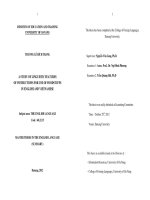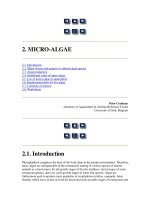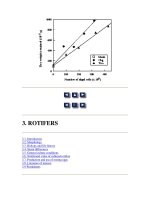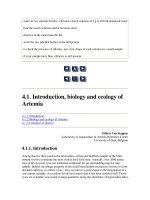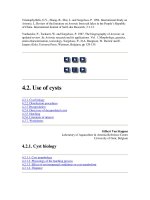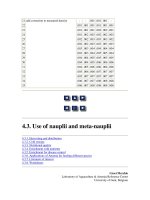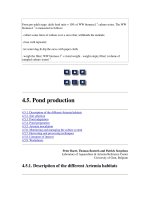Adolescent nutritional awareness and use of food
Bạn đang xem bản rút gọn của tài liệu. Xem và tải ngay bản đầy đủ của tài liệu tại đây (185.16 KB, 8 trang )
RES E AR C H A R T I C L E Open Access
Adolescent nutritional awareness and use of food
labels: Results from the national nutrition health
and examination survey
Janet M Wojcicki
*
and Melvin B Heyman
*
Abstract
Background: Awareness of federal nutrition programs and use of the nutrition facts label are associated with
reduced risk for obesity and increased intake of fruits and vegetables. Relationships between nutrition programs,
use of food labels and risk for overweight and obesity have rarely been evaluated in adolescents.
Methods: Using the National Health and Nutrition Examination Survey from 2005–6, we evaluated the frequency of
nutrition awareness of USDA and CDC nutrition programs and use of food labels in adolescents. Risk for overweight
(BMI ≥ 85-94th percentile) and obesity (BMI ≥ 95th percentile) was assessed in relation to nutrition awareness and
label reading.
Results: Most adolescents (92.4%) were aware of the Food Guide Pyramid. Fewer (43.5%) were aware of the
5-A-Day Program, and even less (29.3%) were aware of the Dietary Guidelines for Americans. Less than 25% of
adolescents decided which foods to purchase by reading material on the nutrition facts label. There were
significant racial and ethnic differences in awareness of federal nutrition programs with Mexican-Americans having
the lowest levels of awareness of the US Dietary Guidelines for Americans and the Food Guide Pyramid in
comparison with other groups. Non-Hispanic whites had higher and African-American adolescents had lower
frequencies of reading fat information on the nutrition label in comparison to Mexican-American and other
Hispanics. Awareness of other nutrition programs or of other information on the nutrition facts label was not
associated with increased or decreased risk for overweight or obesity.
Conclusions: Use of the nutrition facts panel information is low among US adolescents. Additionally, less than half
of adolescents are aware of federal nutrition programs including the Dietary Guidelines for Americans. Future
studies should evaluate avenues to make nutrition information more accessible to young Americans.
Background
Uniform nutrition labels were introduced in the US in
1994 as part of the Nutrition Labeling and Education
Act (NLEA) in an attempt to provide more information
to US consumers to improve eating practices. Use of the
nutrition facts label has been associated with the reduc-
tion of fat and overall energy intake in experimental
studies [1,2]. Knowledge about the nutrition and fat con-
tent of food predicts overall dietary intake in lab-based
studies [3,4].
US federal agencies also have a number of programs and
information sources where residents can get nutrition
information and guidance, ideally improving the dietary
intake of Americans. The US Department of Agriculture
(USDA) and the US Department of Health and Human
Services compiled the Dietary Guidelines for Americans in
2010, which provides dietary recommendations [5]. The
USDA’s Center for Nutrition Policy and Promotion
designed The Food Guide Pyramid, which provides an
outline of how to structure daily food choices based on
the Dietary Guidelines for Americans, an attempt to help
structure daily food choice for Americans [6]. The Food
Guide Pyramid has recently been replaced by MyPlate,
also designed to help Americans structure daily food
choices (USDA) [7]. Another program is the 5-A-Day for
Better Health Program now called the Fruits and Veggie-
More Matters (initially developed by the National Cancer
* Correspondence: ;
Department of Pediatrics, University of California, 500 Parnassus Avenue
MU4E SF, San Francisco, CA 94134-0136, USA
© 2012 Wojcicki and Heyman; licensee BioMed Central Ltd. This is an Open Access article distributed under the terms of the
Creative Commons Attribution License ( which permits unrestricted use,
distribution, and reproduction in any medium, provided the original work is properly cited.
Wojcicki and Heyman BMC Pediatrics 2012, 12:55
/>Institute in collaboration with the Produce for Better
Health Foundation and taken over by the CDC in 2005),
which was designed to encourage fruit and vegetable con-
sumption, including the provision of recipes and tips to
promote fruit and vegetable consumption [8].
The efficacy of these federal programs and guidance to
improve the nutritional health of Americans has not
been extensively evaluated. Evidence suggests that know-
ledge of the Dietary Guidelines for Americans has been
associated with increased likelihood of meeting dietary
guidelines for dairy, protein, and intakes of fruits and
vegetables [9]. However, little is known about the fre-
quency of nutrition facts label reading or knowledge of
federal programs and health outcomes in at-risk popula-
tions such as adolescents who are beginning to make
food purchases for themselves. Furthermore, little infor-
mation is available regarding differences based on race
or ethnicity.
US adolescen ts are an important group to target for
nutrition interventions. In 2007–8, adolescents were
reported to have an unacceptably high prevalence of
obesity (34.2% overweight [body mass index (BMI) ≥85
th
percentile] and 18.1% obese [BMI ≥ 95
th
percentile]),
with an even higher prevalence in African-American and
Latino populations [10]. The obesity epidemic has sti-
mulated interest to improve the nutrition edu cation of
teenagers. The Let’s Move Obesity Prevention Campaign
spearheaded by First Lady Michelle Obama stresses the
need to make nutrition facts labels easier to use for con-
sumers and the need for better dissemination of infor-
mation provided in the Food Guide Pyramid and the
Dietary Guidelines for Americans 2010 to help address
the obesity epidemic [11]. We used the National Health
and Nutrition Examination Sur vey (NHANES) 2005–6
to determine frequency of use of the nutrition facts
panel and awareness federal nut rition programs and
guidelines among US adolescents, with particular atten-
tion to differences in population groups based on race/
ethnicity. We secondarily evaluated the relationship
between awareness and frequency of use and risk for
overweight and obesity.
Methods
The NHANE S 2005–6 survey incorporated new ques-
tions to evaluate nutrition awareness of the Dietary
Guidelines for Americans, the Food Guide Pyramid, the
5-A-Day Program, and diet behavior such as use of the
nutrition facts label and the ingredient list. The
NH ANES is a continuous national survey that repre-
sents a stratified multistage probability sample of the
non-institutionalized US population. Health interviews
are conducted in participant’s homes and measurements
are performed in specially designed and equipped mobile
centers [12]. The interview team consists of a dietary
and health interviewers and a physician. Most of the staff
are bilingual in English and Spanish. An advanced com-
puter system is used to enter respondents’ information
using notebook computers. Respondents are able to enter
their own responses to sensitive questions in privacy using
a touch-sensitive computer screen [12]. Transportation to
and from the mobile center is provided if necessary and
participants are provided with compensation for participa-
tion. Adolescents 16 and 17 years of age have to have a
parent read and sign the consent form in addition to sign-
ing a Household Interview Consent Form [13].
This study investigated the relationship between
responses to the diet behavior questions using NHANES
2005-6 data for adolescents between the ages of 16 and
19 (n = 1160 designed to represent a sample size of
16,204,982). Seventeen different questions were asked on
nutrition awareness and diet behavior as part of the
NH ANES 2005–6, although only a sub-sample of the
1160 answered questions on label reading behavior as
described below. The main outcomes of interest were (1)
awareness of nutrition program, and (2) active use of
nutrition panel information defined as ‘always' or ‘most
of the time’ using the nutrition fact label information.
Specifically, awareness of nutrition guidance programs
such as the Dietary Guidelines for Americans, the Food
Guide Pyramid and the 5-A-Day for Better Health
Program was assessed (3 questions) as was use of the
nutrition facts panel and additional label reading behavior
(ingredient list, serving size or health claims information)
(4 questions). The questions were of the form, “Have you
heard of The Dietary Guidelines (or other nutrition
program)?” and was repeated in the same format for the
other nutrition guidance programs [14]. Participants could
answer ‘yes’ or ‘no’ that they were aware of one of the
nutrition programs.
For the question on the food label they were given a
card with a food label on it and asked, “Here is an
example of a food label. This part of the food label is
called the “Nutrition Facts” panel. How often do you use
the Nutrition Facts panel (or other part of the food
label) when deciding to buy a food product?” [14] They
could answer that they ‘never’, ‘rarely’, ‘sometimes’, ‘most
of the time’ or ‘always’ made use of the nutrition facts
panel information, ingredient list, serving size or health
claims information. As part of the NHANES dietary
behavior interview process, additional label readin g be-
havior was assessed among the sub-sample of adolescent
respondents who made use of the nutrition facts panel,
the serving size information, the ingredient list or the
health claims on the package (n = 742). In this subgroup,
label reading behavior was assessed for use of total
calories, calories from fat, total fat content, trans fat
content, saturated fat, cholesterol, sodium, carbohy-
drates, fiber and sugars in making a product selection
Wojcicki and Heyman BMC Pediatrics 2012, 12:55 Page 2 of 8
/>(10 questions). The questions were phrased in the survey
as follows, “When you use the food label to decide about
a food product, how often do you look for information
about X? [14] Would you say always, most of the time,
sometimes, rarely or never?”
Quality assurance and control measures included
using trained interviewers with a Computer-Assisted
Personal Interviewing (CAPI) system to interview each
participant. The CAPI system has built-in consistency
checks to reduce data entry errors. All data were
reviewed by NHANES field staff for completeness and
accuracy [15]. NHANES documentation does not indi-
cate that the diet behavior questions which specifically
asked about aware ness of federal nutrition programs and
use of nutrition facts panel information were tested for
validity or reliability.
As part of the NHANES protocol, participants were
weighed and measured. To collect weight measurements,
participants stood on a floor scale, equipped with a digital
read-out. Standing height was measured using a wall-
mounted stadiometer. The stadiometer was connected to
an automated data electronic database and data were
entered automatically [16]. Body mass index (BMI) was
calculated as weight (kg)/(height (m)) [2] and CDC growth
charts and classifications were were used to determine
overweight and obesity [17]. Adolescent overweight was
defined as having a BMI percentile ≥85
th
or, for those
18 years or older, a BMI ≥25 and <30. Adolescent obesity
was defined as having a BMI percentile ≥ 95th or a
BMI ≥ 30.
Percentages and 95% confidence intervals were calcu-
lated for all means and frequencies. We applied chi-
squared tests to evaluate differences in proportions and
student’s t-tests to evaluate differences in means to com-
pare how socio-demographic and health variables dif-
fered in adolescents who were aware of nutrition
programs and made active use of the nutrition panel
information in comparison with those with did not.
Unadjusted logistic regression models were used to as-
sess binary outcomes for awareness of nutrition pro-
grams and frequent use of the nutrition facts label
(always or most of the time) in relation to adolescent
BMI percentile or category. Interaction terms for race/
ethnicity and different nutrition label reading behaviors
and nutrition awareness were evaluated to determine
possible interactions between these variables and risk for
overweight or obesity. Multivariate logistic models were
used to compute adjusted estimates for the relation
between nutrition awareness and label reading behavior
and risk for adolescent overweight. Models were
adjusted for adolesc ent age, race/ethnicity, foreign born
versus US born and living in poverty. NHANES supplied
sampling weights and strata were used to analyze the
population survey data. All analyses were done using
Stata 11.0 using svy commands for survey data. Data are
expressed as means ± standard errors (SE).
The NHANES 2005–6 surveys received approval from
the National Center for Health Statistics Ethics Review
Board (ERB) (Protocol # 2005–6) [15]. The University of
California, San Francisco (UCSF) Committee on Research
(CHR) concluded that the study did not need ethical
approval as all analyses involved de-identified data.
Results
The mean age of the adolescents surveyed was
17.5 ± 1.1 years. Most were non-Hispanic white (62.8%),
with sizable representation of non-Hispanic African-
Americans (15.8%) and Mexican-Americans (15.8%).
The sample was largely born in US (90.4%), with 20.0%
living in poverty (Table 1).
Almost all of the adolescents surveyed were aware of
the Food Guide Pyramid (92.4%, 95%CI 89.8-94.4).
Fewer (29.3%, 95%CI 25.1-33.8) were aware of the
USDA’s Dietary Guidelines for Americans, while 43.5%
(95%CI 38.1-49.6) were aware of the Center for Disease
Control’s (CDC) 5 A Day for Health Program (Table 2).
Less than 25% of adolescents surveyed stated that they
regularly (always or most of the time) made use of the
information on the nutrition facts label, with the highest
percentage using the total fat on the nutrition facts label
(Table 2). Close to 25% stated that they regularly
checked calories from fat on the nutrition facts label.
Less than 15%, stated that they regularly checked the
cholesterol on the nutrition facts label, looked at the
ingredient list, used serving size or health claims , or
checked sodium or fiber on the nutrition facts label
(Table 2). For all questions asked concerning the nutri-
tion facts label, with the exception of checking calories
and total fat, more than 50% of adolescents stated that
they rarely or never checked the nutrition information.
Table 1 Sociodemographics of national health and
nutrition examination survey (NHANES)
Adolescent Sample (n=1160)
Variable Mean ± SD or % (CI)
Demographics
Age (years) 17.5 ± 1.1
Race/Ethnicity
Non-Hispanic white 62.8 (54.4-705)
Non-Hispanic black 15.8 (9.7-24.5)
Mexican-American 10.7 (7.8-14.4)
Other Hispanic 4.9 (3.3-7.2)
Other 5.9 (3.3-7.2)
Poverty to Income Ratio (PIR
) 2.62 (2.4-2.84)
US Born 90.4 (87.4-92.7)
Living in Poverty (PIR < 1.3) 20.0 (15.3-25.7)
Wojcicki and Heyman BMC Pediatrics 2012, 12:55 Page 3 of 8
/>Significant differences in frequency ba sed on race/
ethnicity were found for all awareness of nutrition
programs and u se of nutrition fact s label among
those surveyed. Non-Hispanic whites had the h ighest
frequency of awareness of the Food Guide Pyramid
and 5-A-Day Health Program, while other Hispanics
had the highest awareness of Dietary Guidelines for
Americans ( Table 3). Mexican A mericans had the
lowest awareness of all three programs.
Race and ethnic background were associated with sig-
nificant differences in nutrition awareness and label
reading behaviors. Non-Hispanic white adolescents were
more likely to check calories from fat , trans fat, satu-
rated fats, the serving size information, and the nutrition
facts label (Table 3). Other Hispanics were more likely
to check sugars, fiber, and carbohydrates, sodium and
the ingredient list (Table 3). Non-Hispanic African-
Americans were least likely to check any of the fat infor-
mation (calories from fat, total fat, trans fats and satu-
rated fat) compared with the other racial/ethnic groups
(Table 3). Statistically significant differences between
ethnic/racial groups were found for awareness of the
Food Pyramid, the use of health claims on the food
package and checking trans fats (Table 3).
Few label-reading behaviors were associated with
increased risk for overweight and obesit y. Checking
cholesterol on the food label was associated with
increased risk for overweight and obesity but only in un-
adjusted analysis (OR 1.89; 95%CI 1.02-3.50) (Table 4).
Other label reading behaviors were not associated with
risk for overweight or obesity (Table 4). Evaluating the
relationship between awareness of nutrition programs,
reading nutrition facts labels and overweight and obesity
in adolescents, only having heard of the 5-A-Day Healt h
program was associated with decreased risk for obesity
in adjusted analysis (OR 0.65; 95%CI 0.46-0.96) and un-
adjusted analysis (OR 0.66; 95%CI 0.46-0.96) (results not
shown). For overweight and obesity, having heard of the
5-A-Day Health Program neared significance in un-
adjusted (OR 0.83; 95%CI 0.66-1.04) and adjusted (OR
0.82; 95% 0.66-1.02). There was little difference between
the unadjusted and adjusted odds ratios evaluating the
relationship between awareness of nutrition programs,
use of nutrition information and risk for overweight and
obesity, except for the loss of significance in the relation -
ship betw een check cholesterol on food labels an d over-
weight and obesity in adjusted analysis ( Table 4). Of
note, of the 17 nutrition variables evaluated in relation-
ship to risk for overweight and obesity in multivariate
analysis, not one was significant. In the analysis of inter-
action between race/ethnicity, overweight and obesity
and label reading behaviors, those who were Mexican-
Americans, in comparison with whites, and use d the nu-
trition fact s panel information or checked trans fats on
Table 2 Nutrition awareness and label reading behaviors in Us adolescents
Variable Yes or Always% (CI) Sometimes% (CI) No or Rarely/Never% (CI)
Awareness of Federal Nutrition Programs (n=1160)
Heard of Dietary Guidelines 29.3 (25.1-33.8) 70.7 (66.2-74.9)
Heard of Food Pyramid 92.4 (89.8-94.4) 7.6 (5.6-10.3)
Heard of 5-a-day Health Program 43.5 (38.1-49.6) 56.2 (50.4-61.9)
Nutrition Label Reading Behaviors (n=1160)
Use Nutrition Facts Panel 16.7 (13.4-20.7) 20.4 (16.5-24.9) 62.4 (58.7-65.9)
Use Ingredient List on Food Label 9.0 (6.4-12.1) 16.1 (13.0-19.7) 74.5 (70.2-78.4)
Use Serving Size on Food Label 11.2 (8.9-14.0) 19.7 (16.4-23.5) 68.8 (65.4-72.0)
Use Health Claims on Food Package 9.3 (6.0-14.0) 18.2 (14.5-22.6) 71.8 (67.2-76.1)
Specific Nutrition Facts Reading Behaviors (n=742)
Check Calories on Food Label 16.0 (13.5-18.8) 26.5 (22.7-30.7) 49.1 (43.9-54.4)
Check Calories from Fat on Food Label 23.7 (18.4-29.9) 25.4 (22.0-29.0) 50.1 (45.6-56.4)
Check Total Fat on Food Labels 26.5 (21.8-31.7) 24.2 (19.1-30.3) 49.3 (43.5-55.2)
Check Trans Fat on Food Labels 16.4 (11.6-22.6) 20.5 (16.5-25.2) 63.2 (56.8-69.1)
Check Saturated Fat on Food Labels 17.9 (14.1-22.4) 22.9 (18.5-27.9) 59.2 (51.6-66.4)
Check Cholesterol on Food Labels 13.0 (9.0-18.3) 26.6 (22.4-31.3) 60.4 (54.0-66.5)
Check Sodium on Food Labels 13.3 (10.4-17.0) 20.4 (17.4-23.7) 66.3 (61.6-70.7)
Check Carbohydrates on Food Labels 21.8 (18.0-26.1) 25.8 (20.7-31.5) 52.5 (47.0-57.9)
Check Fiber on Food Labels 10.8 (9.0-13.3) 23.6 (19.7-28.0) 65.6 (61.5-69.6)
Check Sugars on Food Labels 21.6 (16.4-27.9) 26.3 (22.4-30.7) 52.1 (44.6-59.5)
Wojcicki and Heyman BMC Pediatrics 2012, 12:55 Page 4 of 8
/>the nutrition facts label were much more likely to be
overweight or obese (OR 3.13; 95%CI 1.56-6.35; OR
2.50; 95% CI 1.08-5.80 respectively).
Discussion
Our study is the first to detail the frequency of nutrition
facts label use among adolescents using a population-
based survey, and the first to evaluate association
between nutrition facts label use and overweight and
obesity. A low percentage of US adolescents regularly
use the information on the nutrition facts label, with
more than 50% rarely or never using the nutrition infor-
mation. Similarly, a low percentage were familiar with
the Dietary Guidelines for Americans, but almost half
were aware of the 5-A-Day program and almost all had
heard of the Food Guide Pyramid.
Our results contrast with previous studies that have
found a higher percentage of US adolescents reading the
nutrition facts label [18-20]. However, none of these
studies was population-based, and the adolescents/young
adults were older than those surveyed in our study. Our
results are also much lower than previous population-
based surveys with adults. The 1995, 1997 and 2010
Shopping for Health surveys found between 54% and
68% of US adult consumers regularly use nutrition labels
when shopping for food items [21-23].
This is the first study to suggest significant racial/
ethnic differences in awareness of nutrition programs
and use of the information on the nutrition labels. Spe-
cifically, Mexican-American adolescents had the lowest
awareness of nutrition programs, and African-American
adolescents were the least likely to check fat information
on the nutrition facts label. This differs sharply from
other studies with adults that have found 78% of African-
Americans read nutrition labels when purchasing food
items [24]. Our results may have diverged from previous
studies with older African-American due to concomitant
health issues such as diabetes mellitus or hypertension
that necessitate more frequent label reading, in contrast
with the younger population of African-American adoles-
cents surveyed in NHANES who likely do not have a high
prevalence of these health issues. Other studies have found
that adults with chronic disease have a higher frequency
of use of nutrition facts labels [25].
Recently, Wright and Wang [26] analyzed awareness
of federal dietary programs in adults older than 15 years
of age using the same NHANES 2005–6 survey data.
They found that that awareness of the Dietary
Table 3 Nutrition awareness and label reading behaviors in adolescents by race and ethnicity
Mexican-American% (CI) Other Hispanic% (CI) African-American % (CI) White % (CI)
Variable
Nutrition Awareness* (n=1160)
Heard of Dietary Guidelines^ 11.9 (9.9-14.3) 41.1 (19.3-67.0) 29.1 (19.9-40.3) 31.0 (20.4-44.0)
Heard of Food Pyramid^ 75.6 (68.6-81.5) 89.7 (63.6-97.7) 89.7 (83.5-93.7) 96.5 (92.2-98.8)
Heard of 5-a-day Health 30.2 (23.3-38.2) 41.3 (19.1-67.7) 44.5 (37.6-51.6) 45.2 (36.5-54.2)
Label Reading Behaviors
1
(n=1160)
Use Nutrition Facts 14.2 (9.6-20.7) 13.0 (4.4-32.7) 12.0 (8.3-16.9) 18.3 (13.5-24.3)
Use Ingredient List 7.1 (4.3-11.5) 13.0 (3.2-40.6) 8.3 (5.7-11.8) 9.2 (5.8-14.3)
Use Serving Size 9.7 (6.4-14.3) 6.4 (0.7-38.5) 8.0 (6.0-10.5) 12.3 (8.8-16.9)
Use Health Claims^ 7.9 (4.5-13.5) 6.0 (1.1-27.0) 5.2 (3.5-7.7) 9.6 (5.3-16.7)
Specific Nutrition Facts Behaviors (n=742)
Check Calories 14.9 (10.1-21.4) 14.5 (4.0-40.7) 19.8 (10.9-33.2) 17.8 (14.3-21.8)
Check Calories from Fat 21.8 (16.3-28.4) 17.6 (7.7-35.1) 16.1 (13.0-19.8) 25.2 (18.3-33.7)
Check Total Fat 23.6 (17.8-30.5) 36.2 (18.3-59.1) 16.9 (14.3-19.8) 27.9 (21.4-35.5)
Check Trans Fat^ 14.7 (11.4-18.7) 2.4 (1.3-4.1) 10.0 (6.7-14.6) 18.7 (12.1-27.6)
Check Saturated Fat 13.7 (9.6-19.1) 16.9 (4.5-4.7) 11.4 (8.7-14.8) 20.1 (14.3-27.5)
Check Cholesterol 17.4 (14.2-21.1) 8.7 (1.1-46.1) 15.5 (12.8-18.5) 12.7 (7.3-20.9)
Check Sodium 10.5 (7.6-14.3) 15.8 (3.9-46.7) 14.7 (10.8-19.8) 13.5 (10.0-17.9)
Check Carbohydrates 19.8 (15.1-25.5) 29.1 (11.9-55.6) 12.2 (9.2-16.0) 24.6 (20.1-29.6)
Check Fiber 10.0 (6.8-14.4) 14.5 (3.4-44.) 8.7 (6.4-11.7) 10.9 (8.0-14.6)
Check Sugars 21.4 (16.5-27.3) 23.2 (7.8-51.9) 19.1 (14.7-24.4) 22.3 (15.1-31.5)
*Participant answered yes.
^Significant at p<0.05.
1
Participant answered always or most of the time.
Wojcicki and Heyman BMC Pediatrics 2012, 12:55 Page 5 of 8
/>Guidelines for Americans was lowest among older ado-
lescents 16–19 years and higher in older age groups,
while the awareness of the Food Guide Pyra mid was
highest among adolescents compared with older age
groups [26]. Knowledge of the 5-A-Day Program was
lower among adolescents compared with adults < 60 years
but comparable with adults ≥60 years of age. Similar to our
results of low awareness among Mexican-Americans
of federal dietary programs, Wright and Wang found the
lowest awareness of federal dietary guidance among
Mexican-Americans in all age groups [26].
As significant racial and ethnic differences persist in
the incidence of childhood obesity [25], intervention
programs should attempt to address these disparities.
Non-governmental organizations and governmental task
forces are pushing the Obama administration and the
Food and Drug Administration (FDA) to adopt more
consumer friendly nutrition facts labels in part to
address the obesity epidemic [11]. As the US govern-
ment debates how to best address the obesity epidemic
and how to provide accessible nutrition information to
Americans, it is imperative to recognize the current low
use by US adolescents and especially the lowest use
among non-Hispanic African-American and Mexican-
American adolescents.
Of concern, we also found that a low percentage of US
adolescents were aware of the USDA’s Dietary Guidelines
for Americans, and less than half were aware of the 5-A-
Day for Better Health Programs. One of the recommenda-
tions from the 2010’s White House Task Force on Obesity
was to disseminate important nutrition information from
the 2010 Dietary Guidelines through simple, easy action-
able messages [11]. However, educators and public health
workers should be aware of the low reach of the current
guidelines among adolescents. This may be particularly
important as we found that awareness of the 5-A-Day for
Better Health Program was associated with reduced risk
for obesity. As a diet high in fruits and vegetables has been
associated with reduced risk for obesity [27], we suggest
expanding this CDC program to all children and adoles-
cents and potentially incorporating aspects into the
expanded nutrition education programs promoted by the
Let’s Move campaign for school-based nutrition education
[11]. Previous studies have also found that providing nutri-
tion educational information on fruits and vegetables and
computer based communications can increase fruit and
vegetable intakes in adolescents and young adults, suggest-
ing that a more targeted intervention using the 5-A-Day
program could have a positive impact [28].
Of note, none of the 17 nutrition-awareness and label
reading variables evaluated in relationship to overweight
and obesity were significant in multivariate analysis. It is
possible that this lack of association may be related to the
overall low prevalence of label reading behavior among
adolescents, in general, for many of the behaviors sur-
veyed. Further studies need to evaluate why there was no
association between awareness of nutrition programs and
overweight and obesity in adolescents. It is possible that
while many of the adolescents were aware of the pro-
grams, they were not knowledgeable of the components of
the programs or the guidance recommendations.
Limitations
There were specific limitations in conducting this study
that should be considered in interpreting the results. As
questions on awareness of nutrition programs and fre-
quency of use of nutrition information were included
only in the 2005–6 NHANES and not other cycles of the
survey, the sample size for this study was relatively
small. It would have been preferable to use two or more
cycles of the NHANES survey. Additionally, as we
Table 4 Relationship Between BMI≥85
th
percentile or
BMI≥25 in Adolescents and Nutrition Awareness and
Label Reading Behaviors
Variable Odds Ratio
(OR) 95%
Adjusted
2
OR 95%CI
Nutrition Awareness
3
(n=1160)
Confidence
Interval (CI)
1
Heard of Dietary Guidelines 1.04 (0.81-1.34) 1.06 (0.81-1.40)
Heard of Food Pyramid 0.72 (0.40-1.27) 0.72 (0.37-1.40)
Heard of 5-a-day Health Program 0.83 (0.66-1.04) 0.82 (0.66-1.02)
Nutrition Label Reading Behaviors
4
(n=1160)
Use Nutrition Facts Panel 0.80 (0.45-1.40) 0.82 (0.66-1.02)
Use Ingredient List on Food Label 1.30 (0.83-2.04) 1.40 (0.90-2.19)
Use Serving Size on Food Label 1.03 (0.50-2.15) 1.06 (0.50-2.22)
Use Health Claims on
Food Package
0.93 (0.58-1.47) 1.02 (0.66-1.57)
Specific Nutrition Facts Reading Behaviors (n=742)
Check Calories on Food Label 1.48 (0.95-2.31) 1.61 (1.03-2.51)
Check Calories from Fat on
Food Label
1.23 (0.76-1.99) 1.36 (0.81-2.27)
Check Total Fat on Food Labels 1.00 (0.57-1.77) 1.09 (0.61-1.97)
Check Trans Fat on Food Labels 0.97 (0.58-1.62) 1.03 (0.59-1.79)
Check Saturated Fat on
Food Labels
1.10 (0.62-1.95) 1.18 (0.66-2.14)
Check Cholesterol on Food Labels 1.89 (1.02-3.50) * 1.76 (0.95-3.24)
Check Sodium on Food Labels 1.57 (0.85-2.92) 1.59 (0.86-2.94)
Check Carbohydrates on
Food Labels
1.26 (0.74-2.14) 1.32 (0.80-2.16)
Check Fiber on Food Labels 1.00 (0.57-1.76) 1.04 (0.61-1.78)
Check Sugars on Food Labels 1.26 (0.81-1.95) 1.29 (0.82-2.04)
1
Unadjusted logistic regression models.
2
Multivariate logistic regression models. Odds ratios are adjusted for age, race/
ethnicity, foreign born versus US born and poverty status.
3
Participant answered yes.
4
Participant answered always or most of the time *P<0.05.
Wojcicki and Heyman BMC Pediatrics 2012, 12:55 Page 6 of 8
/>conducted many statistical tests to assess for possible
association between awareness of nutritional programs
and use of nutrition facts panel information, some of
our positive results could have been the result of chance
given the number of hypotheses that were tested.
Further studies need to validate our findings with other
adolescent groups.
Also, while the NHANES set of surveys does collect
information on dietary intake including inf ormation on
detailed macro and micronutrient intake, we did not
evaluate awareness of federal nutrition program or use
of nutrition information in relation to adolescent dietary
intake. As the primary goal of this study was to quantify
awareness of nutrition programs and use of nutrition
facts panel in adolescents as well a s assess risk in rela-
tion to obesity and overweight , the relationship between
these factors and dietary intake was outside the purview
of this study.
Conclusions
Previous studies with adults and adolescents have found
that use of the nutrition facts panel is associated with
reduction in overall energy and fat intake [1,2], although
studies have not looked at the relationship between use
of labels or nutrition awareness and risk for overweight
and obesity. Alternatively, our finding an absence of
association may suggest that awareness of nutrition pro-
grams and use of nutrition labels may not be a sufficient
intervention or strategy alone to reduce overweight and
obesity in adolescent s. We did find some race/ethnic
specific differences in relation to u se of nutrition
labels and race/ethnicity. Spe cifically for Mexican-
American adolescent s, use of the nutrition fact s labe l
and checking the amounts of trans fats in a product
was associated with increased risk for overweight and
obesity. Previous studies with adults have also found
that obesity is associated with increased attention to
certain parts of the nutrition fac ts label and likely
reflects concern about losing weight or underlying
health conditions [29].
Follow-up studies, however, should assess the relation-
ship between use of labels and awareness of programs
and meeting certain nutritional standards such as the
dietary reference intake (DRI) for each nutrient.
For follow-up studies, we also recommend collecting
qualitative information from adolescents to ascertain
what aspects of the nutrition facts label might be unclear
and to better understand why the use of nutrition facts
labels is relatively low in young Americans. For example,
limited provision of nutrition or health education in
many US schools may lead to lack of awareness on the
importance of reading labels, thus leading t o less informed
dietary decisions. Alternatively, adolescents may experience
apathy and disinterest in spite of adequate nutrition
education and knowledge about the healthy eating p rac-
tices; qualitative studies w ill help untangle the reas ons for
the low adolescent use of nutrition information.
Competing interests
The authors declare that they have no competing interests.
Acknowledgements
Funding support was providing in part by the USDA Economic Research
RIDGE Program for Small Grants in Nutrition (UC Davis) and NIH NIDDK
080825 (JW) and 060617 (MH). Thanks to Lucia Kaiser for assistance with
interpreting the initial results from our analysis. Also thanks to the UCSF NIH
KL2 scholars program for making suggestions to the manuscript.
Authors’ contributions
JW and MH conceived of the study. JW conducted the statistical analyses
and interpretations. JW and MB wrote up the results and approved the final
manuscript.
Received: 7 July 2011 Accepted: 28 May 2012
Published: 28 May 2012
References
1. Chu YH, Frongillo EA, Jones SF, Kaye GL: Improving patrons’ meal
selections through the use of point-of-selection nutrition labels. Am J
Public Health 2009, 99(11):2001–2005.
2. Temple JL, Jonson K, Recupero K, Suders H: Nutrition labels desease
energy intake in adults consuming lunch in the laboratory. J Am Diet
Assoc 2010, 110(7):1094–1097.
3. Engell D, Bordi P, Borja M, Lambert C, Rolls B: Effects of information about
fat content on food preferences in pre-adolescent children. Appetite
1998, 30(3):269–282.
4. Miller DL, Castellanos VH, Shide DJ, Peters JC, Rolls BJ: Effect of fat-free
potato chips with and without nutrition labels on fat and energy
intakes. Am J Clin Nutr 1998, 68(2):282–290.
5. USDA: Dietary Guidelines for Americans. />dietaryguidelines.htm.
6. The Food Guide Pyramid. 2010. />7. USDA Choose My Plate. />8. Introducing the next generation of 5 A day. 2010, .
9. Kolodinsky J, Harvey-Berino JR, Berlin L, Johnson RK, Reynolds TW:
Knowledge of current dietary guidelines and food choice by college
students: better eaters have higher knowledge of dietary guidance.
J Am Diet Assoc 2007, 107(8):1409–13.
10. Ogden CL, Carrol MD, Curtin LR, Lamb MM, Flegal KM: Prevalence of high
body mass index in US children and adolescents, 2007–8. JAMA 2010,
303(3):242–249.
11. White House Task Force on Childhood Obesity: Solving the Problem of
Childhood Obesity Within a Generation, White House Task Force on
Childhood Obesity. Washington, DC: Report to the President; 2010.
12. About the National Health and Nutrition Examination Survey. .
gov/nchs/nhanes/about_nhanes.htm.
13. National Health and Nutrition Examination Survey.InInterviewer
Procedures Manual. />jan05intprocman.pdf.
14. National health and nutrition examination survey (NHANES 2005–6). Diet
Behavior and Nutrition, www.cdc.gov/nchs/data/nhanes_05_06/sp_dbq_d.pdf.
15. National nutrition health and examination survey. NCHS Research Ethics
Review Board (ERB) Approval. />16.
National health and examination survey (NHANES 2005–6). Mobile
Examination Component description. />nhanes_05_06/meccomp_d.pdf.
17. Center for Disease Control (CDC) Growth Charts. />growthcharts/clinical_charts.htm.
18. Marietta AB, Welshimer KJ, Anderson SL: Knowledge, attitudes, and
behaviors of college students regarding the 1990 nutrition labeling
education act food labels. J Am Diet Assoc 1999, 99(4):445–9.
19. Huang TTK, Kaur M, Mccarter KS, Nazir Niaman, Choi WS, Ahluwalia JS:
Reading nutrition labels and fat consumption in adolescents. Journal of
Adolescent Health 2004, 35:399–401.
Wojcicki and Heyman BMC Pediatrics 2012, 12:55 Page 7 of 8
/>20. Jasti S, Kovacs S: Use of Trans Fat Information on Food Lables and Its
Determinants in a Multiethnic College Student Population. In Journal of
Nutrition Education and Behavior 2010, 42(5):307–14. Epub 2010 July 16.
21. Shopping for Health 1995; New Food Labels, Same Eating Habits?
Washington, DC: Food Marketing Institute; 1997.
22. Shopping for Health, 1997: Balancing Convenience, Nutrition and Taste .
Washington, DC: Food Marketing Institute; 1997.
23. Shopping for Health. 2010. www.foodinsight.org, accessed August 17, 2010.
24. Satia JA, Galanko JA, Neuhouser ML: Food nutrition label use is associated
with demographic, behavioral, and psychosocial factors and dietary
intake among African Americans in North Carolina. J Am Diet Assoc 2005,
105(3):392–402.
25. Post RE, Mainous AG, Diaz VA, Mathesion EM, Evertt CJ: Use of the nutrition
facts label in chronic disease management: results from the national
health and nutrition examination survey. JAMA 2010, 110:628–632.
26. Wright JD, Wang CY: Awareness of federal dietary guidance in persons
aged 16 years and older: results from the national health and nutrition
examination survey 2005–6. J American Diet Assoc 2011, 111:295–300.
27. Madsen KA, Weedn AE, Crawford PB: Disparities in peaks, plateaus, and
declines in prevalence of high BMI among adolescents. Pediatrics 2010,
126(3):434–42. Epub 2010 August 16.
28. Richards A, Kattlelmann KK, Ren C: Motivating 18-to-24-year olds to
increase their fruit and vegetable consumption. J Am Dietetic Assoc 2006,
106(9):1405–1411.
29. Vioque J, Weinbrenner T, Castello A, Asensio L: Intake of fruits and
vegetables in relation to 10-year weight gain among Spanish adults.
Obesity (Silver Spring) 2008, 16(3):664–70. Epub 2008 Jan 17.
doi:10.1186/1471-2431-12-55
Cite this article as: Wojcicki and Heyman: Adolescent nutritional
awareness and use of food labels: Results from the national nutrition
health and examination survey. BMC Pediatrics 2012 12:55.
Submit your next manuscript to BioMed Central
and take full advantage of:
• Convenient online submission
• Thorough peer review
• No space constraints or color figure charges
• Immediate publication on acceptance
• Inclusion in PubMed, CAS, Scopus and Google Scholar
• Research which is freely available for redistribution
Submit your manuscript at
www.biomedcentral.com/submit
Wojcicki and Heyman BMC Pediatrics 2012, 12:55 Page 8 of 8
/>
